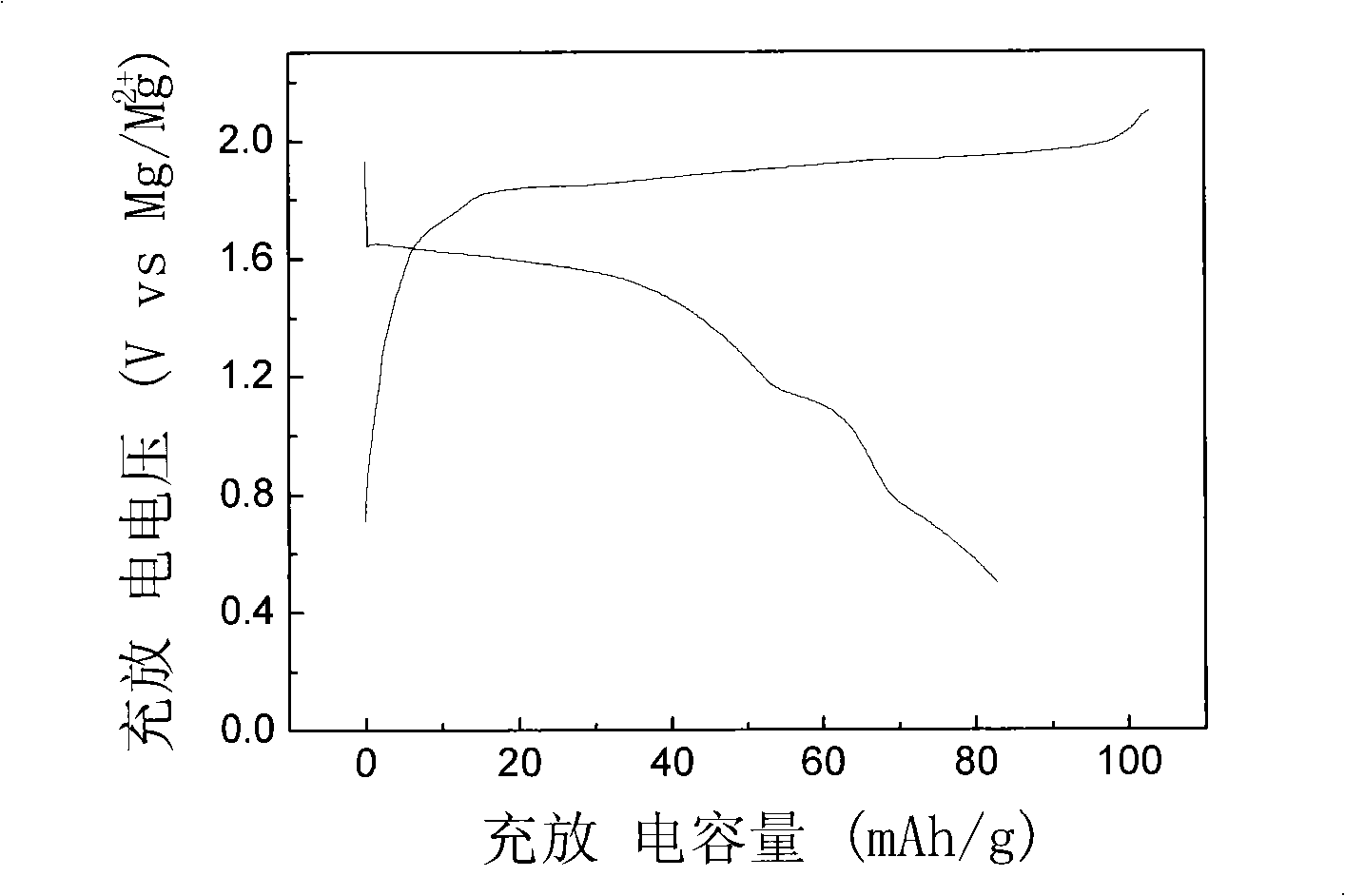Preparation method for anode material manganese magnesium silicate of rechargeable magnesium cell
A positive electrode material, manganese magnesium silicate technology, applied in the field of preparation of battery electrode materials, can solve the problems of harsh preparation conditions, poor oxidation resistance, etc., achieve the effects of shortening the reaction cycle, small polarization, and reducing synthesis costs
- Summary
- Abstract
- Description
- Claims
- Application Information
AI Technical Summary
Problems solved by technology
Method used
Image
Examples
Embodiment 1
[0021] Mix 4 moles of KCl with 1 mole of Mg(CH3 COO) 2 4H 2 O, 1 mole of Mn(CH 3 COO) 2 4H 2 O and 1 mole of SiO 2 After grinding in an agate mortar for 30 minutes, put it into a corundum boat, dry it in vacuum at 100°C for 12 hours, and then heat it at 500°C for 2 hours under the protective atmosphere of argon and hydrogen gas mixture, and then heat it at 1000°C Heat treatment for 6 hours, and finally naturally cool down to room temperature to obtain a manganese-magnesium silicate positive electrode material for a rechargeable magnesium battery.
[0022] A powder X-ray diffraction experiment was carried out on the Rigaku D / MAX2200PC X-ray diffractometer produced by Shimadzu Corporation of Japan with the manganese magnesium silicate as the positive electrode material for the rechargeable magnesium battery prepared above. The experimental conditions are as follows: copper target, X-ray wavelength 0.15406 nm, Ni filter; the light tube voltage used is 40kV, the current is 20...
Embodiment 2
[0026] Mix 4 moles of KCl with 1 mole of MgO, 1 mole of MnCO 3 and 1 mole of SiO 2 After grinding in an agate mortar for 30 minutes, put it into a corundum boat, dry it in vacuum at 100°C for 12 hours, and then heat it at 350°C for 2 hours under the protective atmosphere of argon and hydrogen gas mixture, and then heat it at 1000°C Heat treatment for 6 hours, and finally naturally cool down to room temperature to obtain a manganese-magnesium silicate positive electrode material for a rechargeable magnesium battery.
[0027] A powder X-ray diffraction experiment was carried out on the Rigaku D / MAX2200PC X-ray diffractometer produced by Shimadzu Corporation of Japan with the manganese magnesium silicate as the positive electrode material for the rechargeable magnesium battery prepared above. The experimental conditions are as follows: copper target, X-ray wavelength 0.15406 nm, Ni filter; the light tube voltage used is 40kV, the current is 20mA, the scanning range is 15-75°, an...
Embodiment 3
[0031] Mix 0.464 mol of KCl, 0.336 mol of NaCl with 1 mol of MgO, 1 mol of MnCO 3 and 1 mole of SiO 2 After grinding in an agate mortar for 30 minutes, put it into a corundum boat, dry it in vacuum at 100°C for 12 hours, and then heat it at 350°C for 2 hours under the protective atmosphere of argon and hydrogen gas mixture, and then heat it at 800°C , heat treatment at 900°C or 1000°C for 6 hours, and finally cool down to room temperature naturally to obtain a manganese magnesium silicate as a positive electrode material for a rechargeable magnesium battery.
[0032] A powder X-ray diffraction experiment was carried out on the Rigaku D / MAX2200PC X-ray diffractometer produced by Shimadzu Corporation of Japan with the manganese magnesium silicate as the positive electrode material for the rechargeable magnesium battery prepared above. The experimental conditions are as follows: copper target, X-ray wavelength 0.15406 nm, Ni filter; the light tube voltage used is 40kV, the curre...
PUM
| Property | Measurement | Unit |
|---|---|---|
| particle diameter | aaaaa | aaaaa |
| purity | aaaaa | aaaaa |
Abstract
Description
Claims
Application Information
 Login to View More
Login to View More - R&D
- Intellectual Property
- Life Sciences
- Materials
- Tech Scout
- Unparalleled Data Quality
- Higher Quality Content
- 60% Fewer Hallucinations
Browse by: Latest US Patents, China's latest patents, Technical Efficacy Thesaurus, Application Domain, Technology Topic, Popular Technical Reports.
© 2025 PatSnap. All rights reserved.Legal|Privacy policy|Modern Slavery Act Transparency Statement|Sitemap|About US| Contact US: help@patsnap.com



